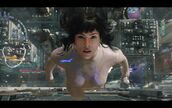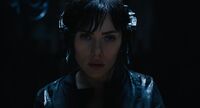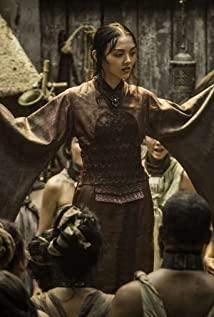Seeing the film ahead of time also felt disappointing in advance. Briefly sort out the plot of the movie version (some names are transliterated, which will be slightly different from the movie version) In 2030, with the development of science and technology, the technology of replacing the human body with machinery is becoming more and more mature, and the human brain can also be electronically connected to the Internet. The major is a full-body prosthetic man made by Hanka Company, and then he worked in Section 9 of the Public Security, responsible for cracking down on crimes on the Internet and prosthetics. In an investigation into the serial murders of high-level Hanka company, the major came into contact with "Kuse", the murderer behind the scenes. And in the process of chasing Kuze, he awakened some of the memories in "Ghost". It turned out that she was a Japanese girl, and Kuze was a part of the anti-mechanization movement, but she was captured by Hanka and her memory was tampered with, and she became the guinea pig of the 2571 plan. Prosthetics, creating a species that surpasses humans and machines. After learning the truth, Major decided to find his lover Kuze and his ghost before being tampered with. The president of the Hanka Company learned that the information had been leaked, and decided to use the thinking chariot to destroy Major and Kuze, and at the same time dispatched private troops to erase the Nine Sections of the Public Security who supported the Major. In the final decisive battle, the major single-handedly solved the thinking chariot, and the members of the nine classes successfully fought against the private army. President Hanka was killed by the old man Aramaki in the voice of the major's authorization. Just look at the plot, the standard Hollywood fast food model. The screenwriter's ability to adapt the profound content of the original "Jack in the Shell" so clumsily shows that he has a strong ability to destroy the film. Although the plot of the movie version is very simple, there are still two things that don't make sense. 1) Before the transformation, Kuze and Major were members of organizations opposed to mechanization. As a result, after the transformation, one became a genius hacker with an electronic brain, and the other became a full-body prosthesis. The things they hate the most are applied to themselves, and there is no turbulence in the two-player drama. This makes no sense. 2) The big villain, President Hanka, did not hide in his heavily guarded company in the final battle, but ran to the abandoned building to remotely control the thinking chariot, and was finally tracked down by the old man Aramaki. The intelligence of being a villain is incredible. It is true that Hollywood ruined another IP, but thanks to them again, "Ghost in the Shell", a niche animation classic, has returned to the public's attention after 20 years. Then I will talk about some differences between the original and the film version. (I am not an iron fan, but I have watched all the animation works of Attack in the Shell and have a basic understanding of the core idea of Attack in the Shell. If the following points are wrong, thank you for correcting.) The movie version of Attack in the Shell is based on the 1995 theatrical version and The 2004 TV version of the animation was adapted from the blueprint, and many fragments of the movie were copied from the 1995 theatrical version. The emotional line of Major and Kuze is based on the animation of the second season. This is a consolation for fans of the original. The main theme of the entire theatrical version of the core of the 95-year-old theatrical version is to explore life and the self. Mamoru Oshii has been asking questions through the mouth of Motoko (major). What is life defined by? Can a bionic machine with an empty body be defined as life? Can a soul without a body continue to live? Who am I? Are the memories that make up my mind just a dream? While raising countless philosophical puzzles, animation in 1995 also explained philosophical viewpoints through the mouth of the characters and guided the audience to find the answer. However, the film version only simply asks whether cyberhumans should be defined as human beings, and even the director has thrown out the view "major, she is a human" through the mouth of a female doctor at the beginning. For the next two hours, the director repeatedly piled up the same answers. By the end of the film, the director himself was already confused, and he even asked the major to say "I am justice" without beginning and end. Motoko (major) in the theatrical version Motoko is a calm and thoughtful character in the original work, such as "Whether the country or the collective, too simplification will only lead to destruction." This classic line is from the mouth of the major. Just the opposite of the ignorant major character in the live-action movie. As the whole body is transformed by prosthetics, Motoko has a deeper understanding and a more radical point of view in the id exploration. So she is more eager to know the answer of the soul than anyone else. However, the film version only simply asks whether cyberhumans should be defined as human beings, and even the director has thrown out the view "major, she is a human" through the mouth of a female doctor at the beginning. For the next two hours, the director repeatedly piled up the same answers. By the end of the film, the director himself was already confused, and he even asked the major to say "I am justice" without beginning and end. Motoko (major) in the theatrical version Motoko is a calm and thoughtful character in the original work, such as "Whether the country or the collective, too simplification will only lead to destruction." This classic line is from the mouth of the major. Just the opposite of the ignorant major character in the live-action movie. As the whole body is transformed by prosthetics, Motoko has a deeper understanding and a more radical point of view in the id exploration. So she is more eager to know the answer of the soul than anyone else. However, the film version only simply asks whether cyberhumans should be defined as human beings, and even the director has thrown out the view "major, she is a human" through the mouth of a female doctor at the beginning. For the next two hours, the director repeatedly piled up the same answers. By the end of the film, the director himself was already confused, and he even asked the major to say "I am justice" without beginning and end. Motoko (major) in the theatrical version Motoko is a calm and thoughtful character in the original work, such as "Whether the country or the collective, too simplification will only lead to destruction." This classic line is from the mouth of the major. Just the opposite of the ignorant major character in the live-action movie. As the whole body is transformed by prosthetics, Motoko has a deeper understanding and a more radical point of view in the id exploration. So she is more eager to know the answer of the soul than anyone else.
The villain in the theatrical version (puppet master) The real villain in the movie version is the president of Hank Company. Compared with the puppet master in the theatrical version, the villain's charm is not a little bit worse. Strictly speaking, a puppet master cannot be defined as a human being. It evolved from an AI program with bugs. In the Internet, it has evolved self-awareness. He believes that humans should not label themselves as the top of the evolutionary tree of life. Humans are like many others. Like the species living on Earth, it is just a fork in the evolutionary tree. It, the puppet master, as a life born from the flood of information, is a new species above human beings.
In the animated version, Kuze appears as the villain in the first half of the movie, and in the second half, he becomes the major's lover. In the "Individual Eleven" incident in the second season of the animation in the shell, "Kushi" is the leader of the refugees, the enemy of the Nine Section of the Public Security, and also the first love of Motoko. He and Motoko experienced an accident together when they were young. They were the only survivors of the accident. During the treatment, the two developed special emotions. But then the two lost contact due to emergencies. During the period of loss of contact, the prosthetics and appearance of the two changed one after another, but Motoko still recognized "Kushi" as his first love during the mission, and the two successfully recognized each other at the end of the animation.
The soundtrack of the theatrical version, Ken Kawai, is second to Ghost in the Shell, just like Hisaishi is to Castle in the Sky. Whenever Kenji Kawai's puppet ballad rings, scenes in the kung fu will surely flash in his mind, and Kenji Kawai's soundtrack successfully adds a religious mystery and mystery to the kung fu. The live-action movie version lacks the soundtrack of Kenji Kawai, which is tantamount to taking away the soul of the shell. Fortunately, the audience can still enjoy part of the original soundtrack in the credits section at the end of the credits. Here is a link to the OST of the shell. The OST capital of the 1995 movie version of Ghost in the Shell is always profit-seeking, and the trick of making money by relying on high-quality IP is no longer the prerogative of domestic directors.
View more about Ghost in the Shell reviews











